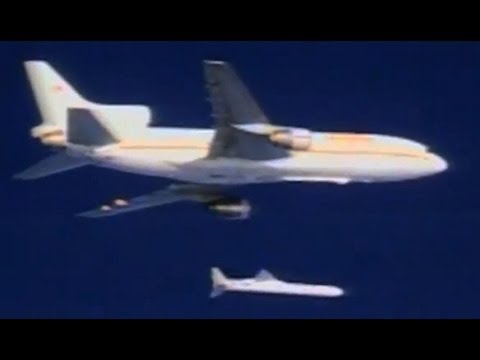more at
An Orbital Sciences Pegasus XL rocket is released from a Lockheed L-1011 TriStar and carries the Interface Region Imaging Spectrograph into orbit.
Public domain film from NASA.
The Interface Region Imaging Spectrograph (or IRIS) is a space probe to observe the Sun by NASA. It is a NASA Small Explorer program mission to investigate the physical conditions of the solar limb, particularly the chromosphere of the Sun. Lockheed Martin Solar and Astrophysics Laboratory (LMSAL) is integrating the observatory. The observatory consists of a spacecraft and spectrometer that LMSAL built, and a telescope provided by the Smithsonian Astrophysical Observatory. Once in orbit it will be operated by Lockheed Martin Solar and Astrophysics Laboratory and NASA Ames Research Center.
Its instrument is a high-frame-rate UV imaging spectrometer; one image a second, 0.3 arcsec spatial resolution, and sub-angstrom spectral resolution.
NASA announced on June 19, 2009 that IRIS was selected from six small explorer mission candidates, along with Gravity and Extreme Magnetism SMEX.
The spacecraft arrived at Vandenberg AFB, Calif. on April 16, 2013 and was successfully launched on June 27, 2013 on a Pegasus-XL rocket…
The Pegasus rocket is an air-launched winged space launch vehicle capable of carrying small, unmanned payloads (443 kilograms (980 lb)) into low Earth orbit. It became operational in 1990 and remains so as of 2013. It is air-launched, as part of an expendable launch system developed by Orbital Sciences Corporation (Orbital). Three main stages burning solid propellant provide the thrust. It flies as a rocket-powered aircraft before leaving the atmosphere.
The Pegasus is carried aloft below a carrier aircraft and launched at approximately 40,000 ft (12,000 m). The carrier aircraft provides flexibility to launch the rocket from anywhere rather than just a fixed pad. A high-altitude, winged flight launch also allows the rocket to avoid flight in the densest part of the atmosphere where a larger launch vehicle, carrying more fuel, would be needed to overcome air friction and gravity…
Pegasus program
The Pegasus’s three Orion solid motors were developed by Hercules Aerospace (now Alliant Techsystems) specifically for the Pegasus launcher. Additionally, wing and tail assemblies and a payload fairing were developed. Most of the Pegasus was designed by a team led by Dr. Antonio Elias. The wing was designed by Burt Rutan.
– Mass: 18,500 kg (Pegasus), 23,130 kg (Pegasus XL)
– Length: 16.9 m (Pegasus), 17.6 m (Pegasus XL)
– Diameter: 1.27 m
– Wing span: 6.7 m
– Payload: 443 kg (1.18 m diameter, 2.13 m length)
Orbital’s internal projects, the Orbcomm communications constellation and the OrbView observation satellites, plus Orbcomm-derived satellites (the “Microstar” platform) served as guaranteed customers and additional seed money. Soon after development began, several government and military orders were placed, as the Scout launcher was slated for phaseout.
The first successful Pegasus launch occurred on April 5, 1990 with NASA test pilot and former astronaut Gordon Fullerton in command of the carrier aircraft. Initially, a NASA-owned B-52 Stratofortress NB-008 served as the carrier aircraft. By 1994, Orbital had transitioned to their “Stargazer” L-1011, a converted airliner which was formerly owned by Air Canada. The name “Stargazer” is an inside joke — in the television series Star Trek: The Next Generation, the character Jean-Luc Picard was captain of a ship named Stargazer prior to the events of the series, and his first officer William Riker once served aboard a ship named Pegasus.
The Pegasus XL, introduced in 1994 has lengthened stages to increase payload performance. In the Pegasus XL, the first and second stages are lengthened into the Orion 50SXL and Orion 50XL, respectively. Higher stages are unchanged; flight operations are similar. The wing is strengthened slightly to handle the higher weight. The standard Pegasus has been discontinued; the Pegasus XL is still being produced. Pegasus has flown 40 missions in both configurations as of October 19, 2008, and two more after that. Of these, 35 were considered successful launches plus the two launches after that…

